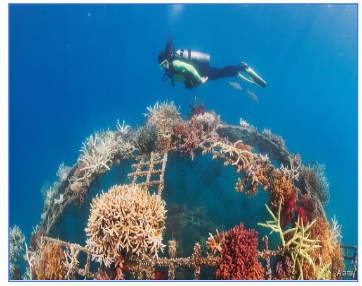Context: The Department of Fisheries has sanctioned 732 artificial reef units for 10 coastal states with a total investment of Rs 126 crore under Pradhan Mantri Matsya Sampada Yojana (PMMSY) for rejuvenating coastal fisheries.
About Artificial Reefs:

- They are engineering technology interventions used to rehabilitate and/or improve natural habitats, increase productivity and manage aquatic resources including habitat enhancement (FAO, 2015).
Advantages of Artificial Reef (AR):
- Similar to natural reefs, ARs are used for aggregating fish and provide a home for fish to live and grow, reduce wave damage on coasts, help regeneration of marine ecosystems and act as a carbon sink.
- As per CMFRI (Central Marine Fisheries Research Institute), a two to three-fold increase in catch rates and efficiency can be realized. Thus saving fuel and energy costs leading to increased income of fishermen.
- It Provides a firm substrate for marine life such as corals, algae and plankton to attach to and grow.
- They provide favorable conditions for sea ranching and serve as spawning and nursery grounds for fish.
- Enhance recreational fisheries, snorkeling, eco-tourism, creating suitable areas for diving and reducing conflicts.
- AR structures restrict bottom trawling in the near shore areas thus helping the marine environment to regenerate and small-scale fishers get higher catch
- One AR of 300m3 is expected to support 25-30 non-mechanized boats (CMFRI).
| Natural Reef:
The coral reef is the most familiar type of natural reef.
- A coral reef is an underwater ecosystem characterized by reef-building corals.
- Reefs are formed of colonies of coral polyps held together by calcium carbonate.
- It is one of the most biodiverse ecosystems on Earth, supporting a wide variety of marine life.
- They are also incredibly important to humans, providing coastal protection, food, and income from tourism and fisheries.
|
Despite the positives of building artificial reefs, we must preserve natural reefs.
Source: PIB
![]() 23 Sep 2023
23 Sep 2023
